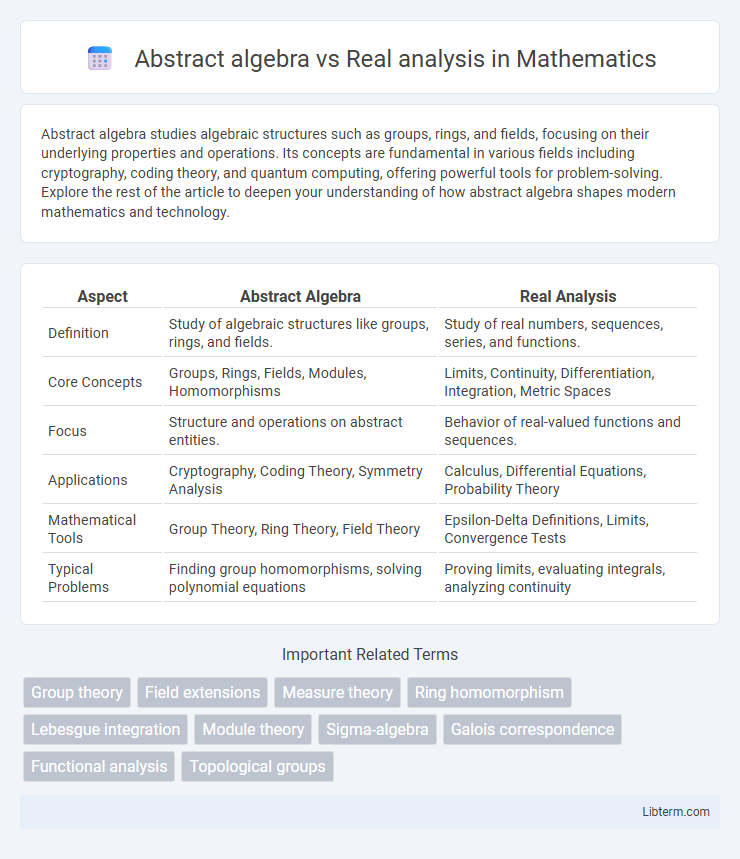Abstract algebra studies algebraic structures such as groups, rings, and fields, focusing on their underlying properties and operations. Its concepts are fundamental in various fields including cryptography, coding theory, and quantum computing, offering powerful tools for problem-solving. Explore the rest of the article to deepen your understanding of how abstract algebra shapes modern mathematics and technology.
Table of Comparison
| Aspect | Abstract Algebra | Real Analysis |
|---|---|---|
| Definition | Study of algebraic structures like groups, rings, and fields. | Study of real numbers, sequences, series, and functions. |
| Core Concepts | Groups, Rings, Fields, Modules, Homomorphisms | Limits, Continuity, Differentiation, Integration, Metric Spaces |
| Focus | Structure and operations on abstract entities. | Behavior of real-valued functions and sequences. |
| Applications | Cryptography, Coding Theory, Symmetry Analysis | Calculus, Differential Equations, Probability Theory |
| Mathematical Tools | Group Theory, Ring Theory, Field Theory | Epsilon-Delta Definitions, Limits, Convergence Tests |
| Typical Problems | Finding group homomorphisms, solving polynomial equations | Proving limits, evaluating integrals, analyzing continuity |
Introduction to Abstract Algebra and Real Analysis
Abstract Algebra explores algebraic structures such as groups, rings, and fields, emphasizing the study of symmetry and structural properties. Real Analysis focuses on the rigorous examination of real numbers, sequences, limits, continuity, and differentiation, forming the foundation for calculus. Both subjects develop critical mathematical thinking, but Abstract Algebra deals with discrete structures while Real Analysis addresses continuous phenomena.
Fundamental Concepts in Abstract Algebra
Abstract algebra centers on the study of algebraic structures such as groups, rings, and fields, emphasizing operations and their inherent properties like associativity, identity elements, and invertibility. It explores fundamental concepts like homomorphisms, isomorphisms, and normal subgroups that reveal symmetry and structure within mathematical systems. Real analysis, by contrast, focuses on the behavior of real-valued functions, limits, continuity, and convergence, examining properties rooted in the real number system and metric spaces.
Core Principles of Real Analysis
Real analysis centers on the rigorous study of limits, continuity, differentiation, and integration within the framework of the real number system, emphasizing concepts such as sequences, series, and metric spaces. It provides a foundational understanding of functions and their behaviors by exploring properties like convergence, completeness, and measure theory. Unlike abstract algebra, which focuses on algebraic structures like groups, rings, and fields, real analysis deeply investigates the ordered and topological properties of real numbers to establish precise analytical results.
Historical Development and Evolution
Abstract algebra evolved in the 19th century through the formalization of group theory by mathematicians such as Evariste Galois and Augustin-Louis Cauchy, shaping modern algebraic structures like rings, fields, and groups. Real analysis developed from the rigorous foundations of calculus in the 19th century, with pivotal contributions from Karl Weierstrass and Bernard Bolzano that emphasized limits, continuity, and measure theory. Both fields have undergone extensive evolution, with abstract algebra influencing cryptography and theoretical physics, while real analysis underpins probability theory and functional analysis.
Key Differences Between Abstract Algebra and Real Analysis
Abstract algebra studies algebraic structures such as groups, rings, and fields, emphasizing operations and their properties, while real analysis focuses on the rigorous behavior of real-valued functions, limits, continuity, and convergence. Abstract algebra is more concerned with discrete and structural aspects of mathematics, whereas real analysis deals with the continuous and infinite processes found within the real number system. The key difference lies in abstract algebra's focus on algebraic systems and symmetry versus real analysis' emphasis on mathematical rigor related to calculus and real numbers.
Applications in Mathematics and Other Fields
Abstract algebra provides foundational structures such as groups, rings, and fields, which are essential in cryptography, coding theory, and quantum physics for modeling symmetry and solving algebraic equations. Real analysis offers rigorous tools for understanding limits, continuity, and integration, playing a critical role in differential equations, mathematical modeling, signal processing, and economic theory. Both fields contribute uniquely to computational mathematics and advanced theoretical research, with abstract algebra excelling in discrete systems and real analysis underpinning continuous phenomena.
Major Theorems and Results
Abstract algebra highlights major theorems such as Lagrange's Theorem, the Isomorphism Theorems, and the Fundamental Theorem of Finite Abelian Groups, which provide deep insights into group structure and symmetry. Real analysis emphasizes critical results like the Intermediate Value Theorem, the Bolzano-Weierstrass Theorem, and Lebesgue's Dominated Convergence Theorem, essential for understanding continuity, convergence, and integration of real-valued functions. These theorems define the foundational frameworks and tools for their respective branches, influencing numerous applications in mathematics and related fields.
Learning Approaches and Study Techniques
Abstract algebra requires mastering symbolic manipulation and understanding algebraic structures such as groups, rings, and fields through rigorous theorem-proof methods, making active problem-solving and abstraction exercises essential for effective learning. Real analysis emphasizes grasping limits, continuity, and convergence with a focus on epsilon-delta definitions, benefiting from visualization, stepwise proofs, and continuous practice of challenging exercises. Both fields demand consistent engagement with formal logic and proof techniques, but abstract algebra leans more towards algebraic intuition, while real analysis prioritizes analytical rigor and precision.
Career Paths and Research Opportunities
Abstract algebra offers career paths in cryptography, coding theory, and theoretical physics, with research opportunities in group theory, ring theory, and algebraic geometry. Real analysis provides foundations for careers in quantitative finance, data science, and mathematical modeling, emphasizing research in measure theory, functional analysis, and differential equations. Both fields open doors to academia, advanced industry roles, and interdisciplinary scientific research.
Choosing Between Abstract Algebra and Real Analysis
Choosing between abstract algebra and real analysis depends on your mathematical interests and career goals. Abstract algebra focuses on algebraic structures such as groups, rings, and fields, essential for cryptography, coding theory, and theoretical physics. Real analysis emphasizes the rigorous study of real numbers, sequences, and functions, providing foundational tools for calculus, probability, and applied mathematics.
Abstract algebra Infographic

 libterm.com
libterm.com